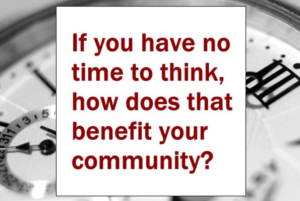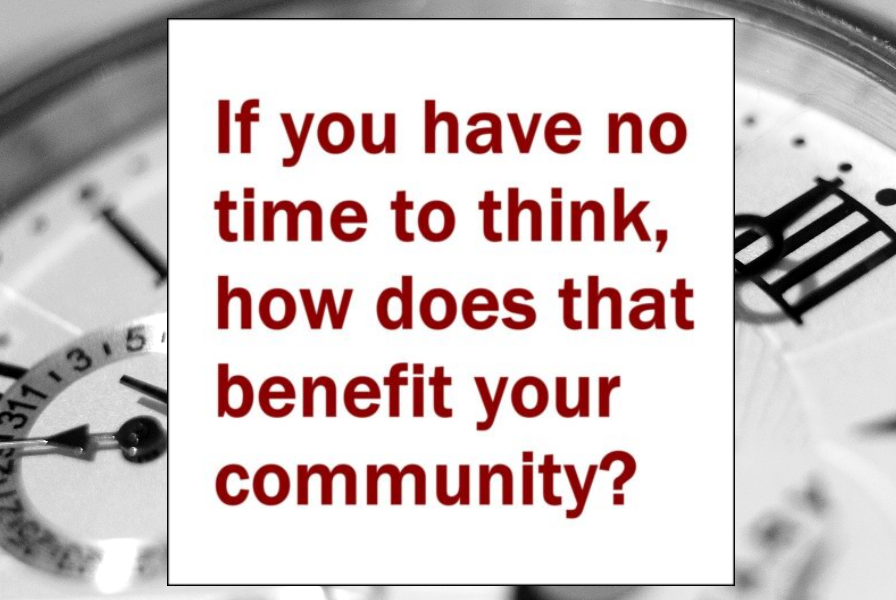Current Tools You Can Use NOW

Announcement
WEBINAR: February 28, 2023
Visionary Results Start With Visionary Questions
As a subscriber to this newsletter, you know that Catalytic Thinking can make a huge difference in your social change work. Next week’s webinar will give you a chance to help embed the questions of Catalytic Thinking more deeply into your work… and your life! The live portion will provide 2 full hours of Q&A and conversation. You also get video lessons, worksheets, and so much more. If you haven’t already registered, now is your chance. Here’s why we’re excited about this!
Tools You Can Use NOW:

Taking Time
to Think and
Recharge
Late last year, when we asked our community to determine what’s next for our mission, you noted three major benefits our work could provide.
- A place to learn about Catalytic Thinking
- Spaces to connect with other Catalytic Thinking practitioners
- Inspiration to experiment in your own work, to live in a space of inquiry.
Last week, when we shared the first steps we will be taking to create those results, the step most people responded to was this one:
In the short term, we will be taking slow, quiet time to build first steps. That slow time will include taking time for recharging our batteries. If we are to create pathways to the outcomes you defined, we need to be energized and ready.
Overwhelmingly, the response was some form of this:
I wish we could do that at our organization.
We could never do that at our organization.
You all are so lucky!
First, let’s make one thing clear.
We are NOT lucky. We are intentional about ensuring our people are at their best as we move forward. If we are exhausted and burned out, with no time to think, how does that benefit you, our community?
That is why in this edition of our newsletter, we'll use Catalytic Thinking to help you find ways to create space to recharge, to think slowly, to be the very best you can be.
Question 1:
Who would be affected by any decision you make about creating space to think and recharge? What would it take to include those individuals in this decision?
Off the top of our heads, there is your staff, volunteers, and board members. From there, the people affected by those individuals would include the families of those team members, your clients / patrons, your partners, your community members.
Look at the impact that one simple action could have on so many people! If this question does nothing else (and it does a lot!), it reminds us of the interconnected consequences of every action we take (or don't take).
This question also leads you to consider how the people who will be affected by those consequences can be the ones to guide and inform your actions.
Question 2:
What could “creating space to think and recharge” make possible for all those people who would be affected?
You are probably thinking of answers to that question as you’re reading right now! Those answers might include…
-
- More creativity
- More slow time to explore options
- Feeling caught up, not feeling under-the-gun
- The physical and emotional health and well-being of your team members
- Lower turnover / higher employee satisfaction and retention
- Better results in your community
Your ultimate answer might sound something like, “healthy people creating a healthier community.”
Question 3:
What conditions would lead to that outcome? What would your team members need to have in order to be more creative, mindful, well-rested? What might they need to be assured of? What would they need to know?
-
- Your team might need to be assured that critical work would get done, that community members would continue to be served.
- Your team might need to know the parameters of the “recharge”
- Your team might need to be encouraged to actually take that time to think and be (vs. filling the time with meetings because they feel they must).
- Your team might need to have assurance that EVERYONE in the organization is included. That it’s not just the C suite, but the people in the warehouse, and the case managers, and the box office staff, and the janitors… EVERYONE.
Questions 4, 5, 6, and on…
What conditions would lead to each of those conditions?
This is where we lay the dominoes that will lead to our ultimate results. For every conditions noted in Question 3, you will ask the same questions about those responses.
-
- What would it take for people to be assured that critical work will get done? What would people need to know? What would they need to have?
- What would it take for people to be assured that this would apply to everyone? What would people need to see? What would they need to experience?
And so on. Ask these follow-up questions in response to each subsequent answer. “And what would it take for THAT to be in place?” Just like stepping backwards to determine when to leave for the airport in time for your flight.
The last question:
The more you step backwards to lay those dominoes, the more actions will become clear.
-
- What actions will we take to ensure we can create those conditions?
- Who might we partner or share with, to help ease the load for both our partner(s) and ourselves?
Walking through the questions of Catalytic Thinking, we begin to see that there are all sorts of ways we can take more time to think and be, to catch up, to recharge. You can see some ideas and examples at this post, but remember: every individual and every organization is different.
The important thing is that we create intentional time to breathe. That alone might be the key to not only retaining employees, it might be the key to accomplishing the mission of social change organizations - to make our communities healthier, more humane, more equitable places to live.
Because we can't create health "out there in the community" if we are not creating health for ourselves as well.
Help Keep Our Programs Freely Available
Most of the programs at Creating the Future are free or low cost, with liberal tuition assistance when they aren’t.
If you find our programs of benefit, we hope you will consider contributing, to help keep these programs available to as many people as possible. Donate here ...
eJournal Archives:
If you’re new to our eJournal, or just want to remind yourself of past practice exercises we’ve shared, check out our eJournal archives here.
SUBSCRIBE
to get this e-Journal
Creating the Future is a 501(c)(3) tax exempt organization in the U.S.A

